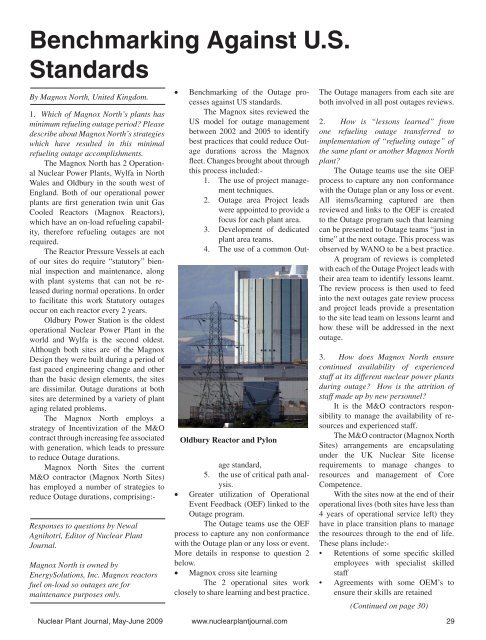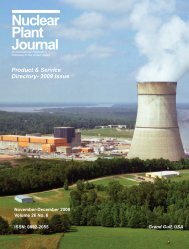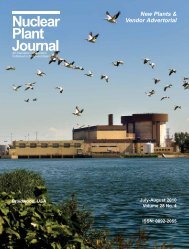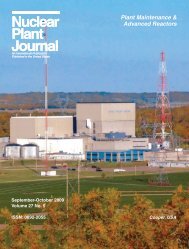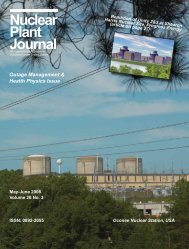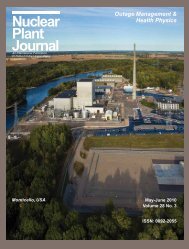Nuclear Plant Journal Outage Management ... - Digital Versions
Nuclear Plant Journal Outage Management ... - Digital Versions
Nuclear Plant Journal Outage Management ... - Digital Versions
Create successful ePaper yourself
Turn your PDF publications into a flip-book with our unique Google optimized e-Paper software.
Benchmarking Against U.S.<br />
Standards<br />
By Magnox North, United Kingdom.<br />
1. Which of Magnox North’s plants has<br />
minimum refueling outage period? Please<br />
describe about Magnox North’s strategies<br />
which have resulted in this minimal<br />
refueling outage accomplishments.<br />
The Magnox North has 2 Operational<br />
<strong>Nuclear</strong> Power <strong>Plant</strong>s, Wylfa in North<br />
Wales and Oldbury in the south west of<br />
England. Both of our operational power<br />
plants are first generation twin unit Gas<br />
Cooled Reactors (Magnox Reactors),<br />
which have an on-load refueling capability,<br />
therefore refueling outages are not<br />
required.<br />
The Reactor Pressure Vessels at each<br />
of our sites do require “statutory” biennial<br />
inspection and maintenance, along<br />
with plant systems that can not be released<br />
during normal operations. In order<br />
to facilitate this work Statutory outages<br />
occur on each reactor every 2 years.<br />
Oldbury Power Station is the oldest<br />
operational <strong>Nuclear</strong> Power <strong>Plant</strong> in the<br />
world and Wylfa is the second oldest.<br />
Although both sites are of the Magnox<br />
Design they were built during a period of<br />
fast paced engineering change and other<br />
than the basic design elements, the sites<br />
are dissimilar. <strong>Outage</strong> durations at both<br />
sites are determined by a variety of plant<br />
aging related problems.<br />
The Magnox North employs a<br />
strategy of Incentivization of the M&O<br />
contract through increasing fee associated<br />
with generation, which leads to pressure<br />
to reduce <strong>Outage</strong> durations.<br />
Magnox North Sites the current<br />
M&O contractor (Magnox North Sites)<br />
has employed a number of strategies to<br />
reduce <strong>Outage</strong> durations, comprising:-<br />
Responses to questions by Newal<br />
Agnihotri, Editor of <strong>Nuclear</strong> <strong>Plant</strong><br />
<strong>Journal</strong>.<br />
Magnox North is owned by<br />
EnergySolutions, Inc. Magnox reactors<br />
fuel on-load so outages are for<br />
maintenance purposes only.<br />
• Benchmarking of the <strong>Outage</strong> processes<br />
against US standards.<br />
The Magnox sites reviewed the<br />
US model for outage management<br />
between 2002 and 2005 to identify<br />
best practices that could reduce <strong>Outage</strong><br />
durations across the Magnox<br />
fleet. Changes brought about through<br />
this process included:-<br />
1. The use of project management<br />
techniques.<br />
2. <strong>Outage</strong> area Project leads<br />
were appointed to provide a<br />
focus for each plant area.<br />
3. Development of dedicated<br />
plant area teams.<br />
4. The use of a common Out-<br />
Oldbury Reactor and Pylon<br />
age standard,<br />
5. the use of critical path analysis.<br />
• Greater utilization of Operational<br />
Event Feedback (OEF) linked to the<br />
<strong>Outage</strong> program.<br />
The <strong>Outage</strong> teams use the OEF<br />
process to capture any non conformance<br />
with the <strong>Outage</strong> plan or any loss or event.<br />
More details in response to question 2<br />
below.<br />
• Magnox cross site learning<br />
The 2 operational sites work<br />
closely to share learning and best practice.<br />
The <strong>Outage</strong> managers from each site are<br />
both involved in all post outages reviews.<br />
2. How is “lessons learned” from<br />
one refueling outage transferred to<br />
implementation of “refueling outage” of<br />
the same plant or another Magnox North<br />
plant?<br />
The <strong>Outage</strong> teams use the site OEF<br />
process to capture any non conformance<br />
with the <strong>Outage</strong> plan or any loss or event.<br />
All items/learning captured are then<br />
reviewed and links to the OEF is created<br />
to the <strong>Outage</strong> program such that learning<br />
can be presented to <strong>Outage</strong> teams “just in<br />
time” at the next outage. This process was<br />
observed by WANO to be a best practice.<br />
A program of reviews is completed<br />
with each of the <strong>Outage</strong> Project leads with<br />
their area team to identify lessons learnt.<br />
The review process is then used to feed<br />
into the next outages gate review process<br />
and project leads provide a presentation<br />
to the site lead team on lessons learnt and<br />
how these will be addressed in the next<br />
outage.<br />
3. How does Magnox North ensure<br />
continued availability of experienced<br />
staff at its different nuclear power plants<br />
during outage? How is the attrition of<br />
staff made up by new personnel?<br />
It is the M&O contractors responsibility<br />
to manage the availability of resources<br />
and experienced staff.<br />
The M&O contractor (Magnox North<br />
Sites) arrangements are encapsulating<br />
under the UK <strong>Nuclear</strong> Site license<br />
requirements to manage changes to<br />
resources and management of Core<br />
Competence.<br />
With the sites now at the end of their<br />
operational lives (both sites have less than<br />
4 years of operational service left) they<br />
have in place transition plans to manage<br />
the resources through to the end of life.<br />
These plans include:-<br />
• Retentions of some specific skilled<br />
employees with specialist skilled<br />
staff<br />
• Agreements with some OEM’s to<br />
ensure their skills are retained<br />
(Continued on page 30)<br />
<strong>Nuclear</strong> <strong>Plant</strong> <strong>Journal</strong>, May-June 2009 www.nuclearplantjournal.com 29


